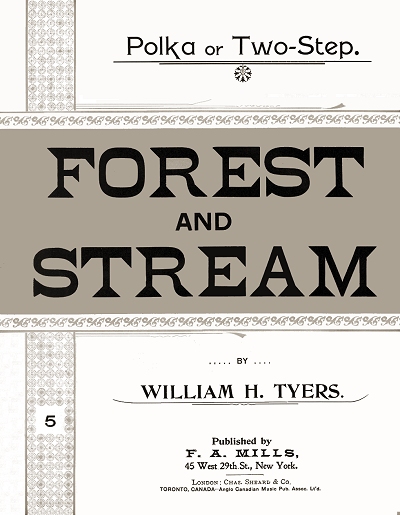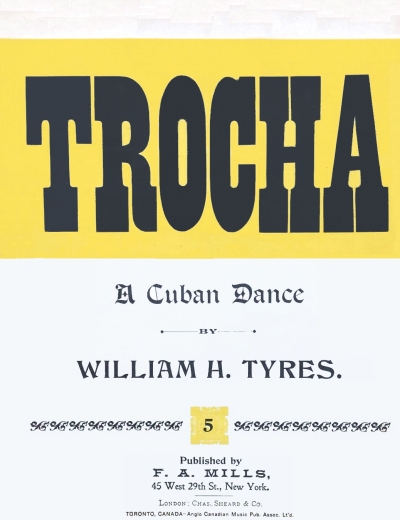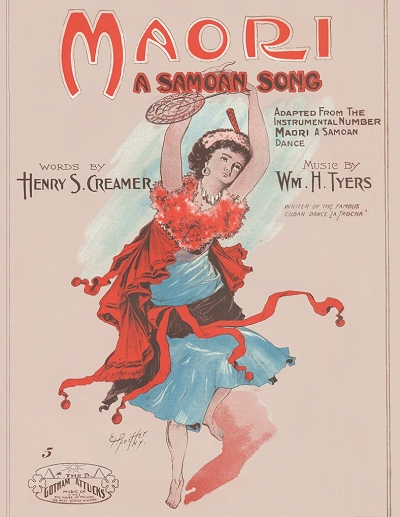|
William Henry Tyers (March 27, 1870 to April 18, 1924) | |
 Compositions Compositions | |
|
1890
Garnet: Grand March1896
Sambo: Characteristic Two-Step MarchTrocha: A Cuban Dance Cupid's Dance: Polka 1897
Forest and Stream: Polka or Two-StepSpring Songs: Waltzes The Empire Quadrille 1898
The TrailDance de Philippines Scene de Ballet: Polka Mazurka 1899
Aunt Mandy's Wedding: March and CakewalkThe Barnyard Shuffle: March and Cakewalk The Trooper's Review La Mariposa (The Butterfly) [reissued in 1948 as Brazilian Butterfly] 1900
Happy Hobo: March [1]The Summer Moon: Entr'acte 1901
La Coqueta (The Coquette): DanceLa Fiancée: Waltzes 1902
A Darktown Flirtation1904
Mockin' Bird Rube: Characteristic MarchThe Squee Gee: Characteristic Two-Step 1905
A Fabian Romance: Intermezzo |
1906
Meno d'Amour (Love's Menu)1908
Maori: A Samoan Dance1910
Smyrna: A Turkish Serenade (1910/14)Panama (1910/11) 1912
Tout à Vous: Valse PetiteThe Silhouettes (Dancing Shadows): Idyl 1913
Trocha: Tango [New Arrangement]Maori: Samoan Song [2] 1915
Admiration: Hawaiian IdylMele Hula: A Pacific Island Dance Love's Contentment: Valse 1916
The Call of the Woods: Valse Descriptive1917
Soliloquy1918
Flames and Fancies: ReverieUniversal Peace 1919
The Woodnymph: Valse Lento1921
Santiago: Tango Fox Trot
1. w/David H. Ross
2. w/Henry S. Creamer |
 Selected Arrangements Selected Arrangements | |
|
1897
I Don't Like No Cheap Man [Williams & Walker]Take Your Clothes and Go [Irving Jones] Since Ma Hair Turned Red [Carroll Fleming] 1899
Harlem Rag (#3) [Tom Turpin]She's A Perfect Lady - No Mistake [Nathan Bivins] I've Got Chicken on the Brain [Elmer Bowman/Al Johns] There Ain't No Use to Keep on Hanging Around [Irving Jones] I Don't Understand Rag Time [Irving Jones] Got Your Habits On [John Queen] Look Here, Mr. Yaller Man [Deas and Wilson] Honey, Give Me One More Chance [Al Brown & Percy Y. Clarke] You Can't Prove It By Me [Jeff De Mount & H. Wise] 1900
I Got de Headache Now [Williams & Walker]The Ghost of a Coon [William & Walker] 1902
New Popular Ragtime Medley [Various Composers]The Pipe Dream [Mose Gumble] The Levee Rag [Charles Mullen] 1906
May Irwin's Rag Time Dance [May Irwin]Get an Automobile [M.H. Watts] 1909
Mexatexa (A New Dance) [Lewis F. Muir]That Teasin' Rag [Joe Jordan] 1910
The Sycamore - Concert Rag [Scott Joplin]1911
The Mad House Rag [Edgar Leslie & Freddy Watson]Quentano: Cuban Intermezzo [James M. Shaw] 1913
La Rumba: El Danzon Sociadal [J. Tim Brymn]Junk Man Rag [Charles Luckeyth Roberts] 1917
Cousin Jasper [Jess Winne]Caresses des Yeux: Intermezzo [Richard Barthélemy] | |
William H. Tyers was a free-born mulatto of former Virginia slaves Henry Tyers and his wife Jane "Jennie" Jones. He was born in 1870 in Petersburg, Virginia, just south of Richmond. Many biographies state his birth year as 1876, and some show one or both of his parents born outside the U.S. However, U.S. census records, including the 1870 enumeration, are very clear and consistent on both his birth year of 1870 and on the birthplace of both of his parents as Virginia.

After spending his first 12 years in Richmond, Virginia, Will's family moved to New York City to find a better situation. It was there that he found some interest in music and started piano lessons. Will's teacher was clear that the boy showed a propensity not just for performance, but for composition, harmony and theory as well. Will started writing a number of pieces, although not initially published, in the mid-1880s, among them well-developed polkas and waltzes. His experiences increased his interest in music, and he set out to make it his living.
Around the time he was 20, Will's training led him to a job as a music librarian and perhaps an arranger [although unconfirmed] for a touring concert company. One of those tours was to Europe, where in Hamburg he fell into a good opportunity to study orchestration and arranging with one Professor Gaspari. It was possibly from this venture that his first published composition appeared, Garnet: Grand March. Eventually Will's health started to deteriorate while on the tour, so he made his way back home to the United States, arriving from Hamburg in Manhattan on November 16, 1891 on the Normannia. He kept working in music and arranging, building up a good reputation. In 1896 Will submitted his syncopated march composition Sambo for publication. Some consider it to be the first true instrumental rag [although this is a disputed status]. It was issued by Frederick Alan "Kerry" Mills who would later contribute the cakewalk At a Georgia Campmeeting, the waltz song Meet Me In St. Louis, Louis, and the intermezzo Red Wing into the world of ragtime era music. An orchestrated version of Sambo was soon available for New York bands to play. However, it was his Cuban dance Trocha that really brought attention to Will, and also his propensity for Latin or "Island" rhythms. It was rearranged and reissued in 1913 as a tango.
This success led to an arranging job with the Joseph W. Stern firm in 1897. Where this is remarkable is that he was hired for his talent in spite of his race, the latter being a constant barrier for many, even in the more liberal environs of New York and Chicago. Many composers and arrangers of any race could never have hoped for a staff job at such a large publishing firm at that time, much less the guarantee of a salary, but Tyers was able to break through that racial ceiling successfully. His hiring may have been in part because Stern recognized the coming popularity of black music forms, and aside from the Gotham-Attucks music formed later, he was one of the leading publishers of black-composed ragtime and popular song in New York in the 1900s and 1910s.
he was one of the leading publishers of black-composed ragtime and popular song in New York in the 1900s and 1910s.
 he was one of the leading publishers of black-composed ragtime and popular song in New York in the 1900s and 1910s.
he was one of the leading publishers of black-composed ragtime and popular song in New York in the 1900s and 1910s.One of Tyer's early assignments was the rearrangement of Tom Turpin's groundbreaking Harlem Rag, which Stern had recently obtained. Will changed it considerably from its first two editions. It will never be known how many manuscripts were touched up or altered by Tyers before they reached the typesetting stage, but some of the more considerable works under his hand did warrant an arranging credit. Many others may well have been saved from obscurity under Tyers' supervision. His talent got him work arranging for songs for The Policy Players (1899), the second of the New York City musical shows by the team of Bert Williams and George Walker. Williams would go on to be a star in the famed Ziegfeld Follies. Another fine but often overlooked Tyers work from 1898 was The Trail, which is one of the earliest examples of an American-based tango tune. On May 18, 1898, Will married his first wife, Burdette Bentley. The 1900 census showed Will and Burdette residing in Manhattan, with his occupation listed as musician, rather than just composer, indicating that he was also likely performing.
It is unclear what happened with Burdette, but in 1902, Tyers was remarried to Canadian-born Helena "Lena" Lightfoot. They appeared in the 1905 New York state census living on West 47th Street with Will listed as a music writer. By this time, the output of his own compositions was starting to shift even more to Latin-based or "Spanish-tinged" pieces with habanera rhythms, and he focused on instrumentals, not collaborating on any songs. Many of his own compositions were published by other houses than that of his employer. Among the successes in the Latin style was Maori which brought him increased fame and attention as it was played by bands around the United States. Initially released in 1908, it was repurposed as a song in 1913. It was in early 1910 that Tyers became one of the co-founders of the famed Clef Club of Manhattan, headed by James Reese Europe and assisted by Ford Dabney. Among Will's roles in the organization were as an officer who was able to organize groups for hired performances, and as an assistant conductor to Europe.
headed by James Reese Europe and assisted by Ford Dabney. Among Will's roles in the organization were as an officer who was able to organize groups for hired performances, and as an assistant conductor to Europe.
 headed by James Reese Europe and assisted by Ford Dabney. Among Will's roles in the organization were as an officer who was able to organize groups for hired performances, and as an assistant conductor to Europe.
headed by James Reese Europe and assisted by Ford Dabney. Among Will's roles in the organization were as an officer who was able to organize groups for hired performances, and as an assistant conductor to Europe.The 1910 census showed Tyers as a traveling musician, even though he had maintained a stable spot with Stern until 1913. He likely had to undergo some travel with the Clef Club to venues outside of New York City. In 1910 at their Second Grand Musical Mélange and Dance Fest Will conducted, and perhaps even premiered two of his pieces, Panama and Smyrna. Anything with the name Panama in it was, of course, a hot topic at that time because of the U.S. sponsorship of the construction of the long-awaited canal through that narrow country, linking the Atlantic and Pacific oceans. Tyers' natural sense of Latin rhythms, which some attribute possibly to his father who may have had deeper family roots in South America or the Caribbean, created a flowing piece that was a natural for dance bands to play. It later would become a traditional jazz favorite that is still performed often in the 21st century. Panama also helped to fuel the Tango rage that captivated American dancers and observers in the 1910s. While Panama was published in 1911, Smyrna, emulating Mid-Eastern rhythms, did not appear in print until 1914. These pieces plus other great piano and dance band arrangements helped to keep his name in front of an increasingly musically savvy public.
A notice appearing in a 1912 edition of the New York Evening Post wrote, "Were the name of Strauss appended to the Tout à Vous Waltz by Tyers, it would be one of the most popular waltzes in the world to-day." This was high praise for any composer considering the somewhat endangered status of the dated waltz form by then. That same year found the Clef Club performing at the prestigious Carnegie Hall with Tyers on the podium for some of the numbers, all of which were composed by African-American composers. One of his more famous arrangements of that time was a second take on Junk Man Rag by Charles "Luckey" Roberts, after a version arranged by composer Artie Matthews did not quite satisfy Stern. Junk Man Rag became a big hit for Roberts, including in a song version, and Tyers' arrangement of it is still heard more than a century later. The same is true of a piece that had premiered at a Clef Club concert in 1910 garnering a great deal of attention, That Teasin' Rag by Joe Jordan, another fine Tyers' arrangement.
James Reese Europe's often heavy-handed management of the Clef Club groups, plus increasing distractions to the side like his work with dancers Vernon and Irene Castle, caused some dissension in the organization, and many of them wanted to reorganize. So in 1914, a few months after his position at Stern had ended, Tyers, along with Europe and Dabney, formed a new but similar organization, The Tempo Club. Both Dabney and Tyers acted as Europe's direct assistants and fill-ins, often conducting small orchestras or ensembles for the Castle's many society dance lessons and parties. This led to a standing engagement at the Strand Roof Garden, where Tyers conducted his own orchestra during the mid to late 1910s while Reese, Dabney, and many other younger black musicians went off to the war with the 369th U.S. Infantry "Hell Fighters" Band and brigade. In 1917 Tyers became the earliest African American members of ASCAP, which was formed just three years earlier. He was one of a handful of black artists to receive this honor so early in the society's history.
Both Dabney and Tyers acted as Europe's direct assistants and fill-ins, often conducting small orchestras or ensembles for the Castle's many society dance lessons and parties. This led to a standing engagement at the Strand Roof Garden, where Tyers conducted his own orchestra during the mid to late 1910s while Reese, Dabney, and many other younger black musicians went off to the war with the 369th U.S. Infantry "Hell Fighters" Band and brigade. In 1917 Tyers became the earliest African American members of ASCAP, which was formed just three years earlier. He was one of a handful of black artists to receive this honor so early in the society's history.
 Both Dabney and Tyers acted as Europe's direct assistants and fill-ins, often conducting small orchestras or ensembles for the Castle's many society dance lessons and parties. This led to a standing engagement at the Strand Roof Garden, where Tyers conducted his own orchestra during the mid to late 1910s while Reese, Dabney, and many other younger black musicians went off to the war with the 369th U.S. Infantry "Hell Fighters" Band and brigade. In 1917 Tyers became the earliest African American members of ASCAP, which was formed just three years earlier. He was one of a handful of black artists to receive this honor so early in the society's history.
Both Dabney and Tyers acted as Europe's direct assistants and fill-ins, often conducting small orchestras or ensembles for the Castle's many society dance lessons and parties. This led to a standing engagement at the Strand Roof Garden, where Tyers conducted his own orchestra during the mid to late 1910s while Reese, Dabney, and many other younger black musicians went off to the war with the 369th U.S. Infantry "Hell Fighters" Band and brigade. In 1917 Tyers became the earliest African American members of ASCAP, which was formed just three years earlier. He was one of a handful of black artists to receive this honor so early in the society's history.Will was well above the age of most of his younger Clef Club peers who fought in Europe, so was not eligible to serve. However, after the war ended in late 1918, he was called to France by James Reese Europe where he arranged and played with or conducted Europe's band in Paris and surrounding towns. Among others in that legendary outfit were Willie "The Lion" Smith [playing drums, not piano], Sidney Bechet [playing clarinet in his pre-soprano sax days], and entertainer Tom Fletcher. After returning to the U.S. in 1919, Will was appointed as an assistant conductor to Will Marion Cook's New York Syncopated Orchestra. He toured with them at times over the next three years, including a command performance for King George V in England. Also performing on and off with the group was the operatic soprano Abbie Mitchell. Tyers spent his summers at the beautiful and luxurious Mount Washington Hotel (opened in 1902) in Bretton Woods, New Hampshire with his own orchestra in the Cave Grill. The rest of his time he worked as an arranger for hire for many publishers who sought his services. Among them, his old employee Joseph Stern, Leo Feist, Shapiro/Shapiro & Bernstein, and the G. Ricordi company. If that wasn't enough, he also participated in the declining days of vaudeville as a sometimes musical director and arranger for the white dance team of Billy Rock and Frances White, including their final show together in 1919.
By the time of the 1920 census, Tyers had been again divorced, or at least indicated that in the enumeration, and his father was now residing with him in Harlem. Will was working as a musician and studio teacher on West 136th Street. He would copyright one final composition in 1921. In failing health, his final summer in 1923 was primarily spent at the Mount Washington Hotel. Will Tyers died of acute pneumonia in Manhattan the following spring at age 54. Curiously, his obituary in the New York Age claimed he was the "only race member" of ASCAP, although by this time there had been a few others admitted. Another curiosity is that in spite of his alleged divorced status on the 1920 census, he may still have been legally married to Lena, also mentioned as his widow in the obituary. His estate was left to a "friend," Miss Vera Young, including royalties, his bank account, and the contents of his apartment. To further complicate things and draw suspicion toward Vera, the will was dated April 17, one day before his death. However, after a court battle, Lena was able to re-obtain the legal rights to at least some of the estate. Copyright renewals started appearing around 1930 with her name as the "widow of the author," and continued for at least 15 years. She survived to 1973, having never remarried, and is buried at Woodlawn Cemetery in the Bronx section of New York with her late husband.
Will Tyers' legacy goes far beyond his compositions, as he made it possible for many black composers to proudly see their works in publication and hear them shine in performance, helping to break many racial barriers in publishing and performance.